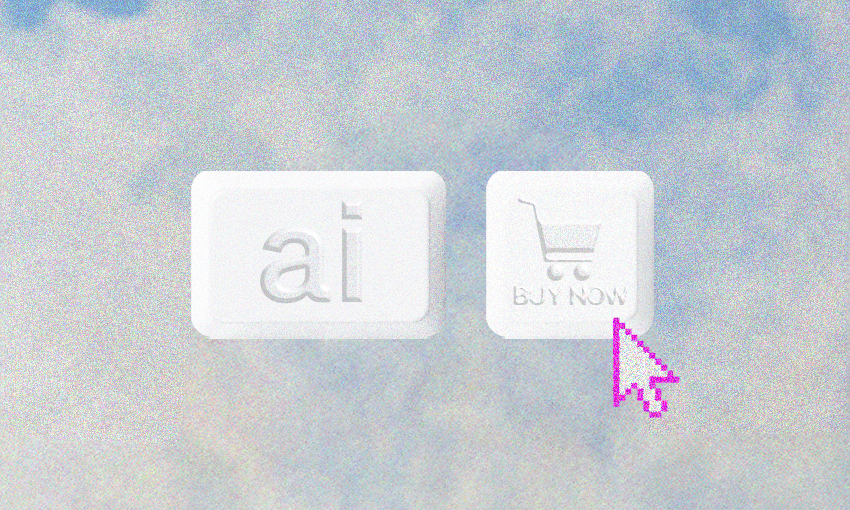As startups like OpenAI dominate technology headlines, it’d be natural to look at the AI space now and feel like you’re already late to the party. But how strong is the signal beneath all of that noise? And have the big ships already sailed?
Back in 1979, Harvard business student Dan Bricklin invented the computer spreadsheet, a piece of software which would eventually be labelled the first “killer app” in personal computing.
Apple’s Steve Jobs said the usefulness and time-saving potential of VisiCalc, as it was called, was “what propelled the Apple II to the success it achieved” and as Bricklin would later recount: “People would tell me, ‘I was doing all this work, and coworkers thought I was amazing. But I was really goofing off because it only took an hour and then I took the rest of the day off. People thought I was a wunderkind but I was using this tool.’”
In recent months, we’ve seen another technological revolution in action, due in large part to the release of a new killer app, ChatGPT, “an artificial intelligence-powered language model … capable of generating human-like text based on context and past conversations”.
The app, which was developed by OpenAI and trained on existing publicly available material on the internet, reached 100 million monthly users faster than any other online application had before. The predominant response from those users seemed to be: holy shit, this is pretty good!
As a recent episode of This American Life outlined, even experienced and quite sceptical researchers from Microsoft (an early and large investor in OpenAI) who had been working in the field of artificial intelligence for years were surprised at its capabilities, and, after testing its problem solving skills, had to conclude it was getting close to replicating human intelligence.
This content was created in partnership with Stake. For more information on what’s happening in innovation and investment, and to join more the more than 60k New Zealanders already investing on Wall Street, visit Stake today and get started.
The rapid and widespread adoption of ChatGPT (and the arrival of other generative visualisation tools like Midjourney, Stable Diffusion and Dall-E) has turned AI into a mainstream topic of conversation and, like other major technology shifts before it, created a mix of fear and excitement.
“ChatGPT put a tangible experience in front of people,” says Justin Flitter, the founder of NZ.AI. “Before that, AI was a dark art, a mystical thing that happened in the background. Not many people could see it or play with it or do anything with it. But now anyone with a browser can use these interfaces and experiment with them.”
For Megan Stals, markets analyst at digital investment platform Stake, the shifts are welcome if not unexpected: “Large companies like Google have been talking about AI for years, but now that GPT-4 has offered something tangible for users, people are realising the technology’s potential to become a true game changer,” Stals explains. “However, companies are still figuring out how it can be monetised, whether that’s a business like OpenAI selling access to GPT-4 or Disney using Midjourney to generate the opening credits for its latest Marvel show. The challenge for investors is determining which companies are genuinely set to benefit, and those using the AI badge to generate hype.”
Chelsea Rapp, who chairs the NZ Game Developers Association and is head of strategy at Christchurch games studio CerebralFix, has a similar perspective. Her industry, like many others, has been working with AI and machine learning for years, but she also thinks the recent advances are a big step forward in terms of capability and is equivalent to the arrival of the personal computer, the internet or the mobile phone.
“I think if anyone looks at AI and doesn’t think it’s revolutionary, they’re not looking hard enough.”
So why is this AI hype different from other recently hyped tech trends like the Metaverse or cryptocurrencies?
“The fundamental difference is that it’s easy to use and get value from,” says Flitter.
While many saw the potential of electricity when it arrived on the scene, it took a surprisingly long time for manufacturers to figure out how to get the productivity gains out of it and the steam age lingered. Rapp says the same may be true with AI and, at this stage, while there is certainly plenty of experimentation and a belief from the market that this technology will make businesses more efficient and profitable, she has yet to see too much in the way of amazing efficiency gains.
“A lot of people are nervous about using the technology and are looking to see how it all pans out.” With text-based tools like Chat GPT and AI image generators like Midjourney pulling from such large data sets (a lawsuit brought by authors arguing that OpenAI ingested their copyrighted work without proper compensation) Rapp also notes the questions raised around intellectual property rights for that content. “Nobody wants to build something around a tool they might eventually have to give back, or might be sued because they used it.”
So what does the rise of these machines mean for society? While many jump straight to the potential loss of jobs (or, for the true AI doomers, the eventual eradication of humans at the hands of an AI hell bent on creating more paper clips), historical precedent would suggest we will adapt.
As tech commentator Benedict Evans wrote in a recent piece about AI: “We should start by remembering that we’ve been automating work for 200 years. Every time we go through a wave of automation, whole classes of jobs go away, but new classes of jobs get created. There is frictional pain and dislocation in that process, and sometimes the new jobs go to different people in different places, but over time the total number of jobs doesn’t go down, and we have all become more prosperous.”
In every other phase of automation, humans have still been required to operate the technology, he says. The spreadsheet didn’t lead to the eradication of accountants. It led to accountants that learned how to use spreadsheets and became more productive. The invention of Adobe Photoshop didn’t make painting obsolete, Rapp says. If anything, it became a tool many painters use. And when humans and computers team up to play chess, they tend to win.
For prospective investors trying to determine which businesses will make most meaningful use of these advancements, says Stals, there’s a virtue in patience. “The big tech companies have been riding the wave of AI hitting the mainstream this year, which has driven a US$4 trillion rally in tech stocks,” she says. “What will be interesting over the next few years are the second-order impacts after the initial hype has died down — how are businesses across the economy going to use those tech tools to create more value? For the healthcare industry that might look like new diagnostic services, while manufacturing businesses could increase productivity and output using AI tools.
Investors could also take the “picks and shovels” approach, Stals notes, by buying companies that form that backbone of AI. “While chipmaker NVIDIA has seen its price skyrocket based on this sentiment already, investors could still find value in less glamorous segments, such as firms providing data centre infrastructure.”
In this new wave of AI innovation, as with any fledgling field, there are still several questions to be answered. In addition to the concerns around intellectual property rights for those whose content is used as training data, Flitter says companies are wary of feeding sensitive material or their own IP into a third-party system without knowing how that data will be used and protected. Some generative AI models have been shown to amplify stereotypes around race and gender, and Flitter notes that there have also been concerns around the accuracy of the information being put forward by these services.
Despite that, he says the AI genie is out of the bottle, and innovation in the hyper-competitive tech sector is unlikely to slow down. But whether you’re an investor or a customer, Flitter says there are a few questions to ask if you want to evaluate where a product sits on the bullshit spectrum. Can you explain the specific algorithm or technology used in the products? How do you collect and label the data required to train your AI models? Is it developed in-house or do you use pre-trained models or APIs from third parties? What are the tangible examples of real word applications where AI plays a central role in your company’s operations? And how do you ensure transparency and ethical considerations in your AI systems?
AI has the potential to impact every industry – even hairdressing, Flitter says. And while agriculture is already highly automated, from precision planting to GPS-based harvesting, to factories that are able to screen produce by weight or defects, he sees more potential in this sector for New Zealand. Local companies like Robotics Plus are experimenting with automated picking and Fruitometry is sending quad bikes with cameras through orchards to gauge readiness and potential yields, while a US company is using AI and lasers to zap weeds and reduce the need for pesticides.
Job losses as a result of automation are a legitimate concern, but in New Zealand, there are also a lot of jobs that can’t be easily filled – and that’s where artificially intelligent bots could help, says Flitter. He also believes that people who know how to use AI tools effectively will move up the employability rankings. And he thinks the same is true when it comes to businesses that invest in AI to ensure they remain competitive.
“I think they will have more of a chance. There are some businesses sitting around the board table seeing AI as an existential threat to their business in two to 10 years. They’re saying ‘if the public perception is that AI automation is good enough, then where is the value that we provide?’”
From an investment point of view, AI has given the US stock market a major boost this year, with the S&P500 up 9% (almost all of which can be attributed to just five big tech stocks) and investors seeing potential for cost savings and greater corporate profits.
This content was created in partnership with Stake. For more information on what’s happening in innovation and investment, and to join more the more than 60k New Zealanders already investing on Wall Street, visit Stake today and get started.
The big tech players have all invested heavily into AI and Rapp says it’s hard to imagine them being knocked out of orbit as a result of this shift. But disruptive eras tend to be fertile times for startups and concerning times for incumbents that slip behind.
Flitter likes the direction Apple is going with its Vision Pro goggles and believes the next technology revolution will be based on a convergence of AI, AR/VR and spatial computing.
“While people might not be able to imagine walking around with a pair of goggles on, I think they can imagine walking around with some kind of screen in front of them that is helping them to navigate through the world. You could be wearing contacts, a nice pair of wearables, or something a bit more far-fetched like an earpiece that projects something only you can see.”
Rapp says we already have prosthetic arms we can move with our minds and plenty of people are experimenting with brain computer interfaces, including the founder of Valve, Gabe Newell, who was stuck in New Zealand during Covid.
“When do we get to the point where our Airpods can listen to our thoughts,” asks Flitter. “I don’t think walking around with a device that you need to type on is productive. The power of thought or speech is so much faster.”
And in our modern, ever-more-productive world, speed is of the essence.

